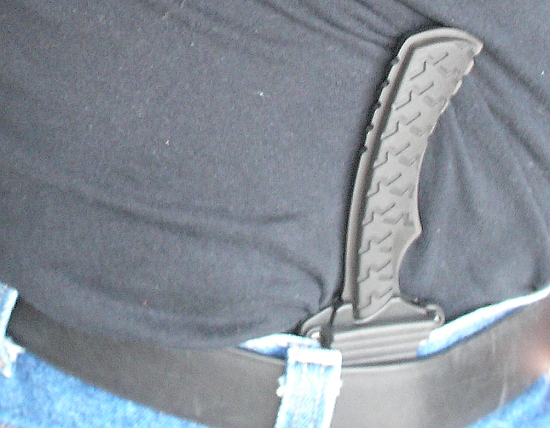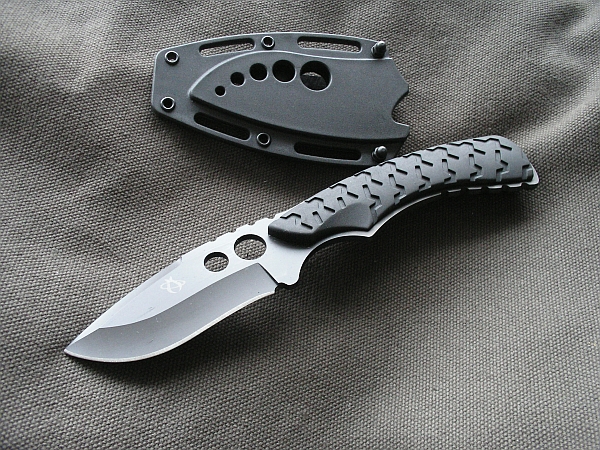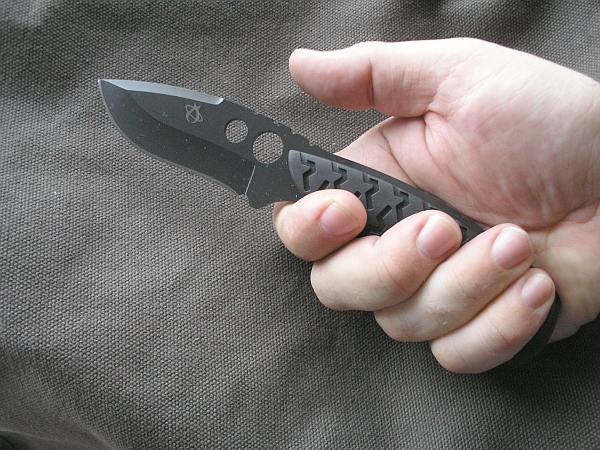Mantis Knives TA2
Review by Phil Elmore
It was in early 2007 when The Martialist first took note of Mantis Knives, a brand that seemed to appear out of nowhere in dealer catalogs and knife magazine advertisements. Contacting a real, live human being through the company's website proved surprisingly easy. We are therefore happy, after a year of living and working with these knives, to present long-term reviews of this company's blades.
 According to Jared West, owner of Mantis Knives, the company was
founded in late 2005 and debuted at the 2006 SHOT Show. "The
Mantis Logo came to me before the name did," Jared told me. "I
was sitting in an International Business class at the Hilton Business
School at L.M.U. in 2001. I was taking notes, and this logo just
hit me, so I scribbled it down. I revised it a couple of
times. Now it's the logo that you see on every Mantis Knives box
that ships out of our Anaheim Hills headquarters."
According to Jared West, owner of Mantis Knives, the company was
founded in late 2005 and debuted at the 2006 SHOT Show. "The
Mantis Logo came to me before the name did," Jared told me. "I
was sitting in an International Business class at the Hilton Business
School at L.M.U. in 2001. I was taking notes, and this logo just
hit me, so I scribbled it down. I revised it a couple of
times. Now it's the logo that you see on every Mantis Knives box
that ships out of our Anaheim Hills headquarters."
That headquarters is a 10,000 square foot facility in Orange County,
California. Some of the knives in the Mantis line are made in the
United States, while others are assembled in Taiwan from US-made
materials (sent by Mantis from Crucible and other sources). The
result is a line of affordable knives of decent quality for the money,
including the only brand of knives officially sanctioned by the United
States Catfish Anglers Tournament Series. "We're the only company
they endorse," Jared states. "We're [also] the only knife
company in the world to offer S30V stainless steel on a folder for less
than $100.00 [USD]."
Jared carries his own company's MK1 model when "hucking boxes and
working in the shop or warehouse." While out on the town, dressed
nicely, or in formal meetings, he carries "my MT2SC. It's slim,
lightweight, and elegant." Price, performance, and style are what
set his company apart from others, according to Jared. "Put our
knives to the test," he urges. "They endure. Every Mantis
knife has a unique, post-modern, industrial look to it. Ever
since I was young, I've been into strange angles and structures in
architecture and design. If I were to design a building, it would
look an awful lot like the Getty Center in Los Angels, or maybe even
the Walt Disny Concert Hall."
At just 27 years old, Jared is a young entrepreneur who seems eager to take on a competitive and often politically charged industry. Mantis' blade materials range from stainless steels like 420HC to more rugged alloys like BG42 and 154CM. Handle materials also range from unusual metal designs to more conventional G10 and carbon fiber slabs.
The Mantis TA2 "Seymore," my favorite among the Mantis knives I have tested, is a fixed blade designed for comfortable grip and ease of wielding. It constitutes what I can only see as a self-defense carry package. It has an plastic IWB sheath with an attached belt clip that, while it won't fit on wide belts, can be easily carried on slimmer ones.
The knife fits into the sheath by friction and locks positively. The contoured hande is of "ZR rated tire rubber" and is extremely comfortable. The grip it provides is very sure, and the grooves cut into the top and bottom of the frame at the rear are nicely placed. There are also grooves at the thumb rest position, which I always prefer.
The three-inch recurved drop point is of 420HC steel. It was very sharp out of the box, cut test media extremely well thanks to its large belly, and penetrated stacked cardboard reasonably well despite a relatively thick point.
It should be obvious from the pictures that at 7 and 7/8ths inches overall, the knife has a much longer handle than it does a blade. This full-sized handle is what makes the knife so comfortable (especially for my fat mitts). It also means the blade feels light and moves very quickly.

This is a simplebut stylish design with a great handle in an efficient package, suitable for self-defense carry. >>

